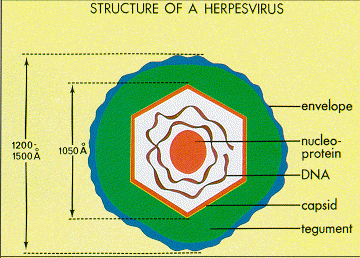


History
Classification
Properties and Taxonomy
Replication
Research
(links above are from previous years' webpages)
Herpesviruses seem to have been around for as long as humankind can remember. The name itself, which means "creeping or to crawl," was coined by Hippocrates, the father of medicine himself. Many of the viruses are still so common that a majority of the population at any given time is seropositive for them.
Herpesviruses are double-stranded DNA viruses with a monopartitic genome. The genome can infection in a healthy cell even without the rest of the virion. As with many other DNA viruses, which must commandeer a DNA polymerase from the host cell, these viruses reproduce in the host nucleus.

The virion itself is made up of four parts: in descending order, the envelope, the tegument, the capsid, and then the core. Herpesviruses are quite large, measuring from 120-200 nanometers in size. The envelope has small glycoprotein projections from the surface, and the tegument beneath it is an amorphous globular structure in lieu of normal matrix protein. The capsid is icosahedral in shape and surrounds a core of nucleic acid wound around a spindle-like protein.
Created by Caroline Perry and Stephanie Robson - March 1st, 2000
Updated by Kiyana Harris and Christine Yang - November 17th, 2005